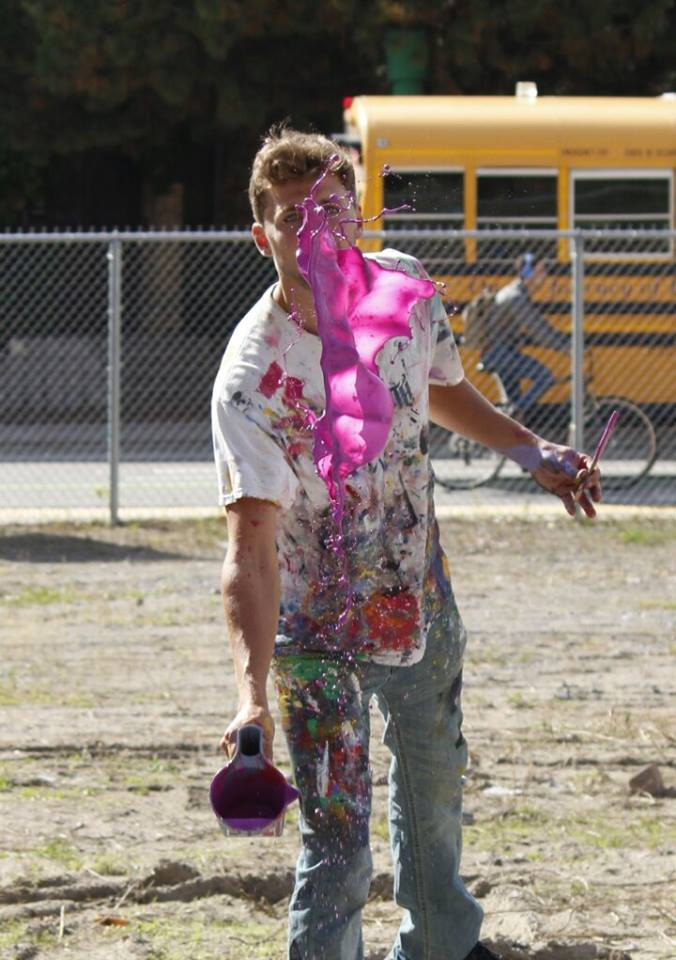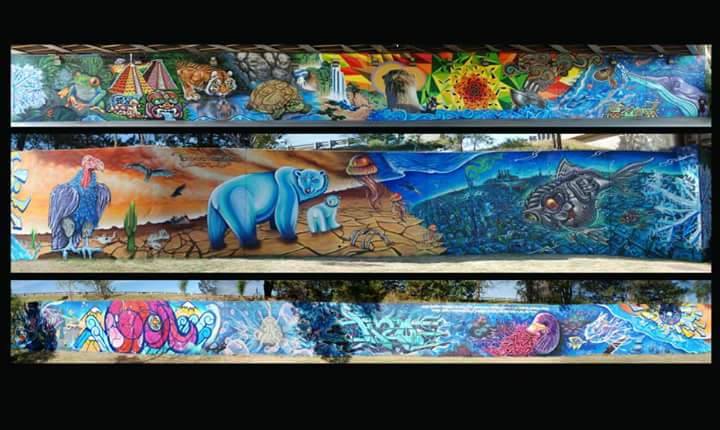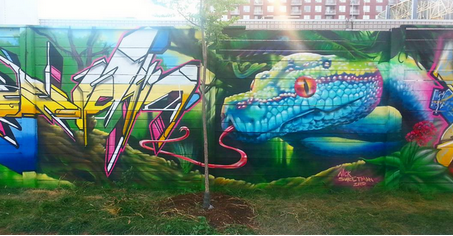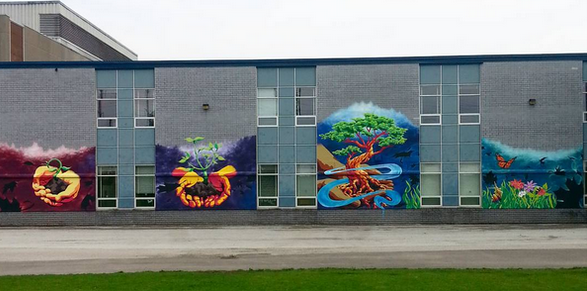 Artist, Nick Sweetman at work. Photo courtesy of Joyann Reid-Thompson
Artist, Nick Sweetman at work. Photo courtesy of Joyann Reid-Thompson
Interview with Nick Sweetman (N.S), one of Toronto’s Professional Street Artists by Ella Gorevalov (E.G)
Toronto is becoming more colorful. More specifically, Toronto’s formerly bland constructions sites are being pioneered with a new form of public art: city-mandated art on construction hoarding. Construction hoarding is the safety fencing that lines a construction site. No longer will we zig-zag across the city to avoid new development projects, as these places are turning into outdoor gallery spaces – displaying the artwork of local artists like Nick Sweetman on their safety fencing.
 PATCH’s newest mural at Sherbourne and Gerrard, titled Pollen Nation, by Nick Sweetman. Photo courtesy of Vadim Taraskine.
PATCH’s newest mural at Sherbourne and Gerrard, titled Pollen Nation, by Nick Sweetman. Photo courtesy of Vadim Taraskine.
Local non-profit The PATCH (Public Art on Construction Hoarding) Project partners up with Toronto-based artists and construction developers to transform Toronto’s streetscape in this up-and-coming platform for art. I interviewed one of the artists on PATCH’s roster, who has recently completed “Pollen Nation”, a PATCH project on Sherbourne and Gerrard.
E.G: Can you tell me about the project, and the process of your work “Pollen Nation” (2015)?
N.S: I’ve worked with The PATCH Project on various different projects. They connect artists and communities through public art, starting a conversation about how to make change through art in public space. For this project, PATCH partnered with developer Oben Flats to put up a mural on pollinators as this space is going to serve as a community garden before being turned into housing units.
I feel passionate about bringing awareness to dwindling bee populations, as science tells us that bee populations are suffering from the things that humans put in the soil. Without pollinators, we don’t have food. The idea originally was to make a Toronto-specific design inspired by local native species but I watched a documentary on pollinators and learned there are a lot more than just insects pollinating plants and I couldn’t pass up the opportunity to display a diversity of animals and color.
 Close up of Pollen Nation. Photo Courtesy of Vadim Taraskine.
Close up of Pollen Nation. Photo Courtesy of Vadim Taraskine.
My process for this mural incorporated creating renderings in Photoshop – taking realistic images and giving them a little bit of magic and action through color and movement. After discussing the idea with my friends, we began to think that wind acts as a catalyst for pollination as well. This is when the paint splatters came about. Paint splatters, all in one direction represented pollen being carried by the wind.
E.G: What is your background in art for the public realm, what draws you to it?
N.S: What I love about public art is the simple fact that it is public. Meaning it is out of the normal sphere of art, not held in an exclusive space designated for art which many people don’t access in their everyday lives. Public art breaks up someone’s day and incites an aesthetic experience when they aren’t ready for it.
I first started out in public realm through graffiti, doing illegal work, but now I am more focused on community engaged projects and collaborative mural. I ended up taking a course at MuralRoutes, which is a great organization that helped me learn the basics: budgeting, planning, funding. They helped me raise my profile.
Through a series of projects through both MuralRoutes and The PATCH Project, I was able to work on art full time. I think my current success is based on me doing by best work, connecting with like-minded people, and following through with everything I promise to do. One of my first big projects was a collaboration with Bruno smoky, Shalak Attack , and Fiya Bruxa (Essencia Art Collective) – which serendipitously came together but subsequently led to many other projects.
 Nick Sweetman’s collaboration with Essencia Collective at Jane and Highway 400. Photo courtesy of Nick Sweetman.
Nick Sweetman’s collaboration with Essencia Collective at Jane and Highway 400. Photo courtesy of Nick Sweetman.
E.G: How do you draw the line between street art and graffiti?
N.S: That depends on what you mean by those words.
The average person might use those terms in less precise ways. But a distinction does exist between street art and graffiti, especially to those that identify as “graffiti” artists. Typically, graffiti is understood to involve lettering, the illegal tagging and ownership of city space, running in crews… I think by and large graffiti is made for other graffiti artists, or for general notoriety. It’s about getting your tag to be the biggest and in the craziest spots. People who are part of this community appreciate it.
Street art is simply anyone making art in the street. Street art has become a very convenient term for art that is not graffiti, as graffiti artists want to distinguish themselves from street artists. The two cultures are different.
Most people, when they use “street art”, aren’t being that specific. Is there a divide? Yes. For some people more than others. For me, if I didn’t learn to spray as a graffiti artist, I would have never gotten to paint these murals now, where I work with communities to create artwork that supports and connects them. So I don’t think that these distinctions are so productive, but I recognize that they exist. Moving forward, it’s interesting to see collaborative pieces where artists are able to straddle both worlds.
 Nick Sweetman’s Python for Wall Expressions, a community restoration project presented in collaboration with StreetARToronto and Toronto Police Service, Mediah, and Team SPUDBomb. Photo courtesy of Nick Sweetman
Nick Sweetman’s Python for Wall Expressions, a community restoration project presented in collaboration with StreetARToronto and Toronto Police Service, Mediah, and Team SPUDBomb. Photo courtesy of Nick Sweetman
E.G: What would be your dream project to work on in the city?
N.S: The STEPS Initiative (which is the larger organization that manages The PATCH Project) produced an amazing project in St. James Town with my friend and artist Sean Martindale. They installed the world’s tallest mural, a colorful image of a phoenix on the entire side of a 32 story condo. This kind of a project is really rare mostly for budgeting reasons. When I first decided to dedicate myself to art full time, I was picturing these types of huge walls. Since then, I’ve thought of something even cooler.
It would be a collaboration between myself and a collection of artists in the city. The idea is giving art as a gift to the city. Step one: create art as a group that weaves together seamlessly – a piece of work where individual contributions to the project merge and become one. Step two: take it apart and install it in various parts of the city in such a way that it seems that the art is an inherent part of the city.
 In Our Hands, murals by Nick Sweetman at Valley Park Middle School, Toronto. Photo courtesy of Nick Sweetman
In Our Hands, murals by Nick Sweetman at Valley Park Middle School, Toronto. Photo courtesy of Nick Sweetman

I think Patch is a great program, the one problem is their “curating” of artists, they keep most of the jobs for their select artists and ignore dozens that are part of the roster. Perhaps those selected for these jobs should be mentoring others or patch could spread the work around more fairly.
This is a very talented artist and has contributed in a positive way to the Toronto street art scene.
Sick work from Nick, I wish there was more diversity in the Toronto street art scene. Every wall I see is done by the same 5 or 6 people. New blood is needed.
I’d just like to say, for the record, that I do not speak for any artist other than myself. The art world is very diverse and people have very different definitions and understandings of how it works. The above words are my opinions, not necessarily facts, and I welcome being corrected.
I definitely agree public art projects in Toronto could better represent the diversity of the city, and there are hundreds, maybe thousands, of talented people in Toronto who could produce an excellent mural who are not being selected for large projects. All I can say to the artists feeling under-represented on the streets is: make moves. Connect with other artists who are doing what you want to do and find out how they did it.